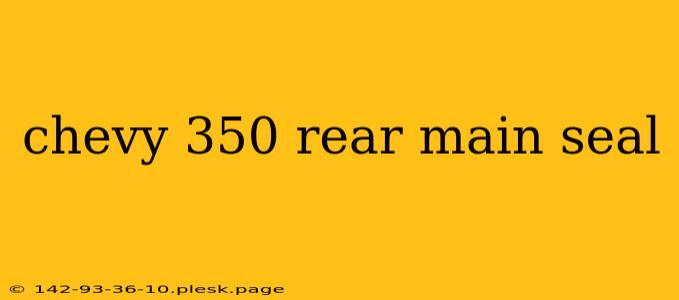The Chevy 350 small-block engine, a legendary powerplant, is known for its durability and ease of modification. However, even these robust engines require maintenance, and one common issue is a leaking rear main seal. This comprehensive guide will walk you through understanding the problem, identifying the cause, and effectively replacing the rear main seal on your Chevy 350.
Understanding the Chevy 350 Rear Main Seal
The rear main seal's primary function is to prevent engine oil from leaking where the crankshaft exits the engine block. Over time, this seal can deteriorate due to age, wear, or improper installation. A leaking rear main seal manifests as oil dripping from the rear of the engine, often accumulating on the transmission bellhousing or the surrounding area. Ignoring this leak can lead to significant oil loss, engine damage, and even a fire hazard.
Identifying the Problem: Is it Really the Rear Main Seal?
Before diving into a replacement, it's crucial to confirm that the leak originates from the rear main seal. Other potential sources of oil leaks in the rear of the engine include:
- Transmission seal: Check the area where the transmission mates with the engine.
- Rear crankshaft seal: This is located at the back of the crankshaft itself. It requires significant disassembly to reach and replace.
- Oil pan gasket: While less likely to be the source of a rear leak, a severely damaged oil pan gasket can sometimes contribute.
Carefully inspect the engine for oil traces to pinpoint the leak's origin. Using a clean rag or paper towels to wipe the suspected area and monitoring for fresh oil seepage can help narrow down the problem.
Replacing the Chevy 350 Rear Main Seal: A Step-by-Step Guide
Replacing a Chevy 350 rear main seal is a moderately challenging task requiring mechanical aptitude and the right tools. This is not a beginner project; if you're uncomfortable with engine work, seek professional assistance. The specific steps may vary slightly depending on the year and model of your engine, so always consult a repair manual specific to your Chevy 350.
Essential Tools and Materials:
- Repair Manual: A factory service manual or a reputable aftermarket repair manual is absolutely essential.
- Socket set: A complete set of metric and SAE sockets will be needed.
- Wrenches: Both open-end and box-end wrenches in various sizes.
- Torque wrench: Crucial for tightening bolts to the manufacturer's specifications to prevent damage.
- Pry bars: Gentle leverage is sometimes needed during disassembly.
- New rear main seal: Ensure you purchase a high-quality replacement seal, specifically designed for your Chevy 350 engine.
- Seal installer: A seal installer tool is highly recommended to prevent damaging the new seal during installation.
- Clean rags and shop towels: For cleaning and wiping excess oil.
- Engine hoist (optional): While not strictly necessary for some approaches, an engine hoist can significantly simplify the process.
Key Steps (General Overview - Consult Your Repair Manual):
- Disconnect the battery: Always disconnect the negative battery terminal before starting any engine work.
- Drain the engine oil: Completely drain the engine oil before removing the oil pan.
- Remove the transmission: This step may be required, depending on the access provided by your particular engine. This is the most challenging aspect of the job.
- Remove the oil pan: Access to the rear main seal is typically achieved after removing the oil pan.
- Remove the old rear main seal: Use a seal removal tool to carefully extract the old seal, avoiding damaging the crankshaft.
- Clean the mating surfaces: Thoroughly clean the crankshaft and the engine block where the new seal will be installed.
- Install the new rear main seal: Use a seal installer to carefully install the new seal, ensuring proper seating and alignment.
- Reassemble the engine: Reverse the disassembly process, carefully installing all components and tightening bolts to the correct torque specifications.
- Reinstall the transmission (if removed): Ensure proper alignment and secure connection.
- Refill with engine oil: Use the correct type and amount of engine oil recommended for your engine.
Preventing Future Rear Main Seal Leaks
Proper maintenance is key to preventing future problems. Regular oil changes using the correct grade of oil, and avoiding prolonged periods of engine idling can significantly extend the life of your rear main seal and prevent premature wear.
This guide provides a general overview; always consult a detailed repair manual for your specific Chevy 350 engine model. Remember, working on an engine involves inherent risks. If you lack experience, seeking professional assistance is highly recommended.

